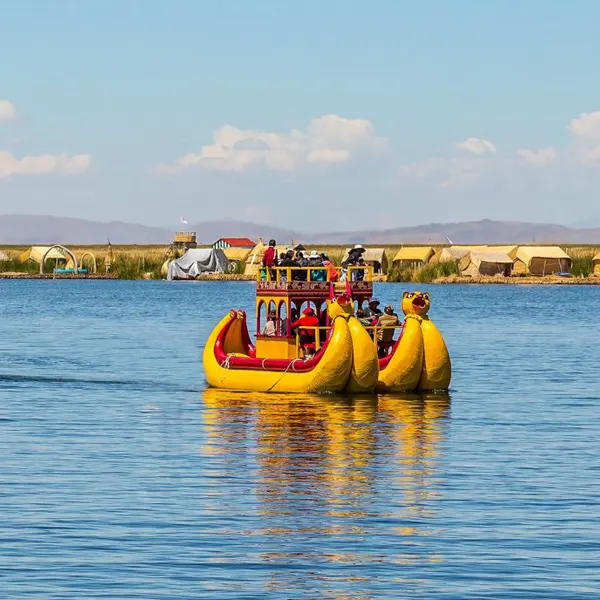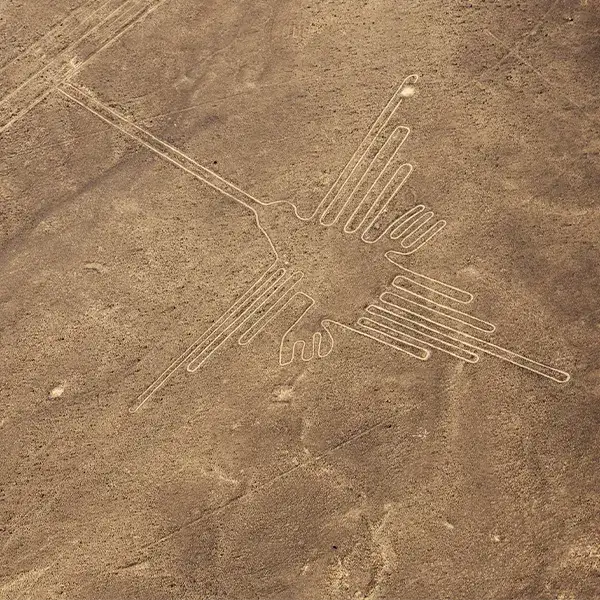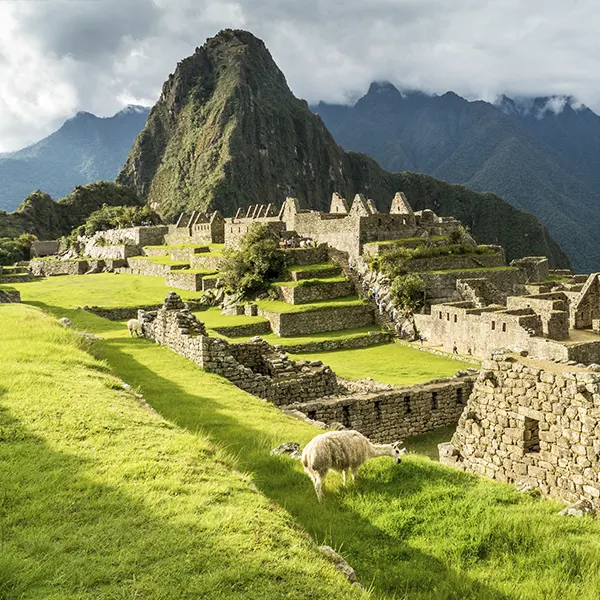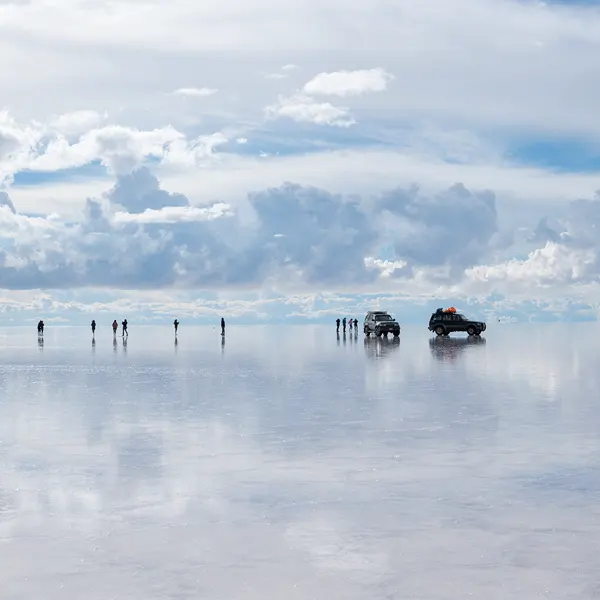Peru is home to several iconic attractions, including Arequipa, Cusco, and Lima, the culinary capital of South America. This country is a destination undoubtedly worth visiting and one that thousands of people yearn to experience. Knowing about its currency is essential if planning a trip to Machu Picchu.
Today, Peruvian prices are generally relatively affordable for tourists outside South American countries. However, this will ultimately depend on the activities you’ll be doing. That’s why the Machu Travel Peru team wants to share everything you need about the Peruvian currency.

The most important things to know about Peruvian money
- About Peruvian currency – Sol
- Exchange rate
- Where to exchange money in Peru
- Be cautious with money in lousy condition
- Counterfeit money in Peru
- Tipping
- Recommendations
- FAQs
About Peruvian currency – Sol
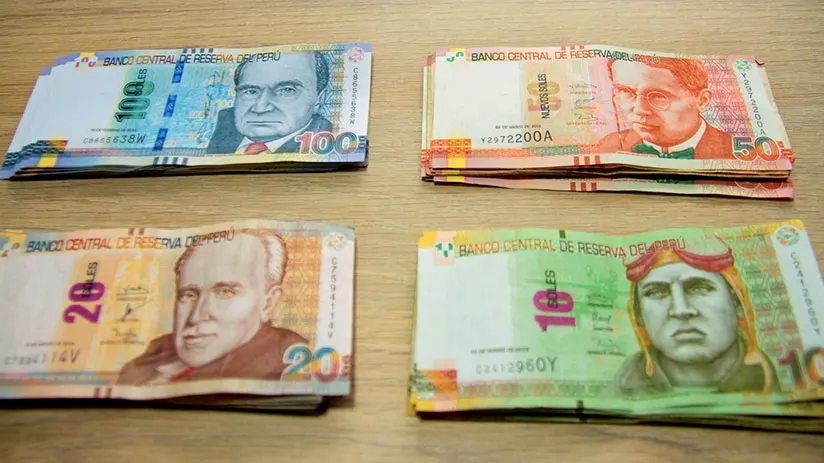
The official currency of Peru is the sol (PEN), symbolized by “S/.“. The term comes from the ancient Peruvian money known as the “sol de oro”. Nevertheless, Peru’s currency history commenced before 1820, during the Spanish colonial real coin era. However, it wasn’t until 1991 that the “nuevo sol” became the official coin, establishing a stable economic point.
Today, the Peruvian monetary unit is one sol, which represents 100 céntimos (10 coins for 10 céntimos). Soles appear on various banknotes and coins with denominations in soles and cents. Peru’s iconic symbols inspire the designs of its currency. Below is a brief table to help you understand the coins and banknotes.
| Coins | Backnotes | |
| Inspired by: Important historical, cultural, and natural symbols, such as the vicuña, the cinchona tree, and the cornucopia. | Inspired by: Relevant historical figures such as Abraham Valdelomar, Túpac Amaru II, and María Rostworowski, as well as historical sites and emblematic landscapes. | |
| Céntimos | Soles | |
| 10 | 1 | 10 |
| 20 | 2 | 20 |
| 50 | 5 | 50 |
| 100 | ||
| 200 | ||
Exchange rate
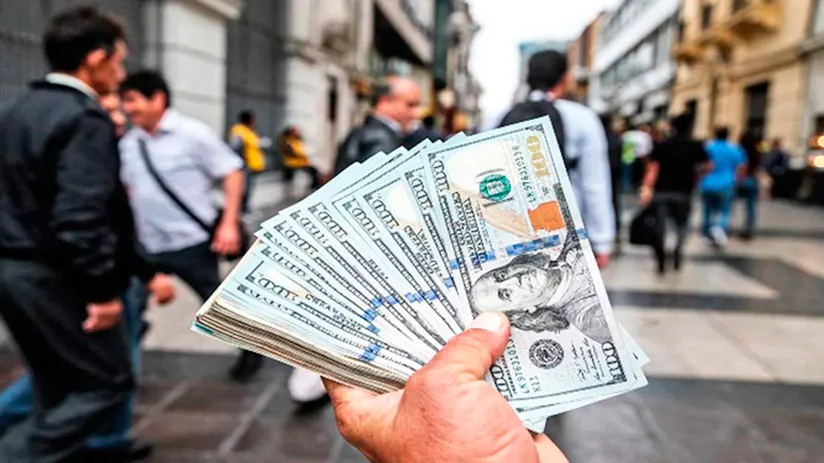
Peruvian money stays stable, although it can vary. Owing to its constant growth in GDP and low levels of external debt. Therefore, the value of one dollar (US$1) fluctuates between three soles and fifty cents (S/ 3.50) and four soles (S/ 4.00). This fluctuation has been especially true for over 10 years, with a few minor exceptions.
Consequently, if you’re keen on currency conversion, remember that not every place provides the exact exchange rate. Commissions and fees for currency conversions usually vary. Therefore, planning carefully before considering the exchange rate and where to exchange currency in Peru is advisable.
Where to exchange money in Peru
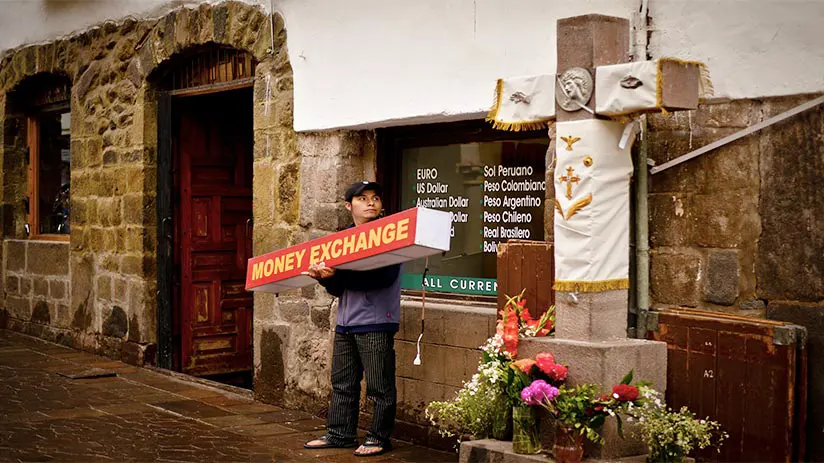
Exchanging money in Peru is easy, especially in urban and tourist areas. We recommend comparing the different exchange rates before converting. Below are some of Peru’s most common options for exchanging foreign currency.
- Exchange houses are the safest option for exchanging money, as they usually offer better exchange rates and lower fees. Although they accept all currencies, the dollar and the euro are the most common. Their transparency and fair transactions give them a good reputation, but checking the exchange rates in advance is advisable.
- Luxury hotels and airports are convenient for travelers looking for a safe environment, although they offer high fees. These options are viable for exchanging small amounts and only for necessary situations.
- Banks in Peru offer fair rates but can be time-consuming because of long lines. Additionally, banks require identification, which is a reliable option but less convenient for quick transactions.
- ATMs are another convenient option, offering US dollars and soles withdrawals. However, exchange rates vary, and banks often charge a transaction fee. You can exchange money at ATMs in Peru’s main airports, including Jorge Chávez Airport and Velasco Astete Airport.
- While doing tourism in Peru, it is easy to see people exchanging money on the street. These people, commonly known as mobile currency exchangers, wear colorful vests and badges with the “$” symbol. Although this option is less recommended and unsafe, it offers better exchange rates.
Be cautious with money in lousy condition
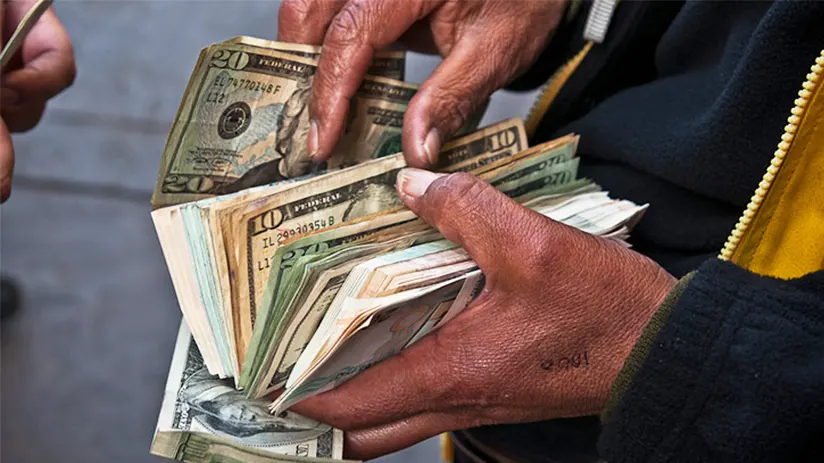
Many establishments do not accept Peru’s money in poor condition, especially the banknotes. As a visitor, you should also take the same precautions when accepting cash. We recommend not accepting torn or severely worn banknotes; this will prevent problems with future payments.
Many money changers, merchants, and locals do not accept foreign banknotes in poor condition, including the US dollar. However, the Central Reserve Bank of Peru can exchange old banknotes for free in any branch. In conclusion, it’s best not to have old bills, whether in soles or dollars and to take precautions to avoid drawbacks.

Counterfeit money in Peru
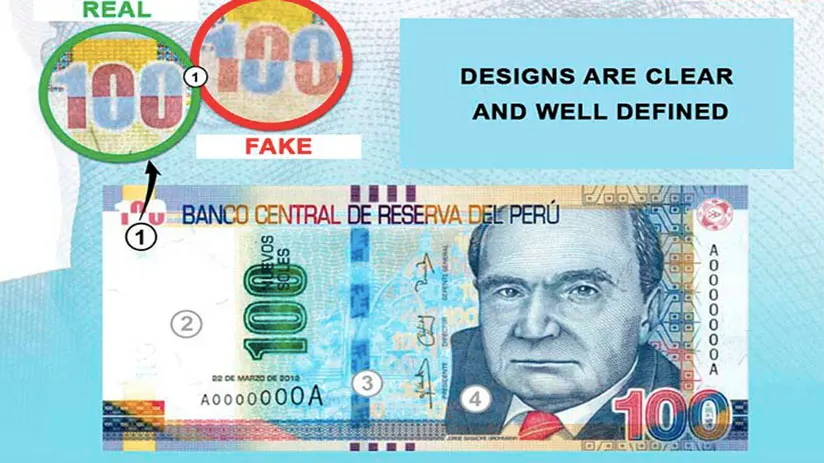
Counterfeiting coins and banknotes is an increasingly common problem for the US dollar and the sol. Today, it is not easy to detect a counterfeit banknote or coin; however, there are several ways to do so. Also common to see merchants, and anyone in general, verify the originality of the money before accepting. Below are some recommendations for checking the banknotes you receive:
- Cotton is the primary material used to make banknotes. Therefore, we recommend touching the characteristic high-relief texture.
- Another easy way is to hold the banknote to the light to see the watermark. These watermarks usually have various shades and match the figures on the banknote’s front and back exactly.
- Banknotes in circulation have international security measures, including the security thread. You can check this by turning the bill slightly and observing a certain dynamism in the figures and the color change.
- Check the series and numbering of counterfeit banknotes on the Central Reserve Bank’s online platform. Although this is an unusual option, if you have doubts about your banknote, it may help clarify things.
As a tourist, you may not notice the subtle differences. If you have coins, for example, 20 and 50 céntimos coins, this may not be a problem you should worry about. However, we recommend carefully considering large one-hundred or two-hundred soles (S/. 100 or S/. 200) bills.
Tipping

Various establishments in Peru have adopted alternative payment methods over time. Today, Peruvians and tourists use digital wallets, mobile apps, and credit and debit cards more frequently. However, we recommend carrying some cash, particularly for tips. In addition, it is best to have local coins and bills to tip the server because you cannot usually add tips to the bill.
Recommendations
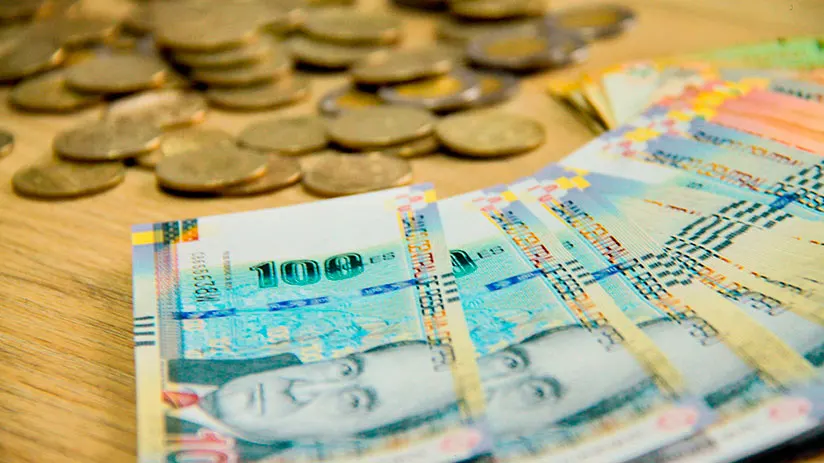
- Feel free to request a replacement for questionable bills when making a purchase.
- Don’t carry much cash, just the necessary amount, as some change will suffice.
- Those who want to pay by card can do so in many establishments.
- Take precautions regarding the exchange service and payment methods if traveling to less-traveled destinations.
- Some establishments accept dollars in Peru; however, this isn’t common.
- If you plan to pay with credit cards, we recommend carrying a copy of your card as a precaution.
- To people interested in buying souvenirs in Peru, it’s best to opt for cash.
FAQs
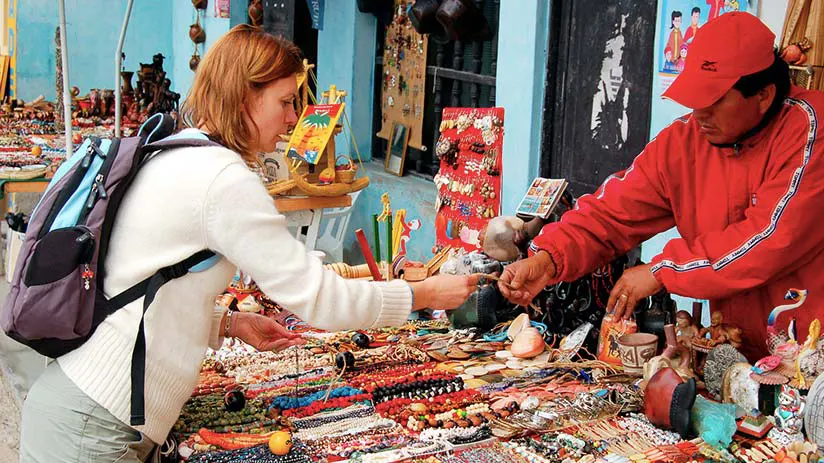
Can I negotiate a price?
Yes, bargaining is common, especially in markets to visit for shopping and street businesses that only accept local cash. This situation is entirely different from specialty stores, but they may offer you some promotions.
What currency should I bring to Peru?
The ideal approach is to carry dollars and exchange them for Peruvian soles. Most countries widely accept dollars and convert them easily. However, some remote destinations in Peru don’t offer these facilities.
Are credit and debit cards accepted in Peru?
Most businesses, restaurants, and hotels accept both credit and debit cards. This is especially true in Peru’s major cities, where many establishments accept Visa, MasterCard, and American Express cards.
Is it safe to use ATMs in Peru?
Of course, if you are interested in security in Peru, we recommend using ATMs at banks and shopping centers. Although most ATMs are safe, we recommend taking precautions in less crowded areas.
Should I give my money in soles or dollars?
Travelers should use Peruvian cash, particularly for tips. While tipping isn’t widespread in Peru, leaving a 10% tip on your purchase is customary. Also, many establishments in Peru only charge soles.
How much does 100 US dollars cost in Peru?
Generally, $100 is equivalent to S/. 350 to S/. 400; however, we recommend checking the current exchange rate. The cost may vary between different establishments because they offer different exchange rates.
What is the best currency to use in Peru?
The Peruvian sol is the best currency to use. Vendors typically list prices in soles, so using dollars or another currency might give you a lousy exchange rate. However, in stores near tourist spots, some offer prices in dollars and soles.
Is US currency accepted in Peru?
Many businesses in Peru, especially in tourist and busy areas, accept United States currency. We recommend being especially careful with the exchange rate, as it tends to be unfavorable.
Is PEN the same as sol?
Indeed, people also know the Peruvian sol, Peru’s national currency, as the PEN.
Remember that all this information is subject to change and is for reference purposes only. The authorities update the exchange rate and coin designs annually. We recommend planning and taking all the abovementioned precautions, especially when handling large bills.
“NOT HE WHO HAS MUCH IS RICH, BUT HE WHO GIVES MUCH”
As we see, money in Peru is a topic to continue exploring. But in general, if you keep these tips in mind, you will not have future problems. If you have any other questions about Peru’s currency, consult the Machu Travel Peru team. Our consultants will gladly help you learn more about this fantastic country.
Peru has so much to offer, it can be hard to know where to start. With many years of experience in the tourism sector, Machu Travel Peru is happy to help with anything regarding your trip to Machu Picchu and any tours around it. Make your Machu Picchu experience an unforgettable one!



